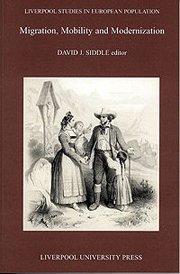Book contents
- Frontmatter
- Contents
- List of Figures
- List of Tables
- 1 Introduction
- 2 Nephews, Dowries, Sons and Mothers: the Geography of Farm and Marital Transactions in Eastern Ireland, c. 1820–c.1970
- 3 Mobility, Kinship and Commerce in the Alps, 1500–1800
- 4 People from the Pits: the Origins of Colliers in Eighteenth-Century South-West Lancashire
- 5 Motives to Move: Reconstructing Individual Migration Histories in early Eighteenth-Century Liverpool
- 6 Urban Population and Female Labour: the Fortunes of Women Workers in Rheims before the Industrial Revolution
- 7 Mobility Among Women in Nineteenth-Century Dublin
- 8 Tramping Artisans in Nineteenth-Century Vienna
- 9 Migration and Urbanization in North-West England: a Reassessment of the Role of Towns in the Migration Process
- Index
9 - Migration and Urbanization in North-West England: a Reassessment of the Role of Towns in the Migration Process
- Frontmatter
- Contents
- List of Figures
- List of Tables
- 1 Introduction
- 2 Nephews, Dowries, Sons and Mothers: the Geography of Farm and Marital Transactions in Eastern Ireland, c. 1820–c.1970
- 3 Mobility, Kinship and Commerce in the Alps, 1500–1800
- 4 People from the Pits: the Origins of Colliers in Eighteenth-Century South-West Lancashire
- 5 Motives to Move: Reconstructing Individual Migration Histories in early Eighteenth-Century Liverpool
- 6 Urban Population and Female Labour: the Fortunes of Women Workers in Rheims before the Industrial Revolution
- 7 Mobility Among Women in Nineteenth-Century Dublin
- 8 Tramping Artisans in Nineteenth-Century Vienna
- 9 Migration and Urbanization in North-West England: a Reassessment of the Role of Towns in the Migration Process
- Index
Summary
INTRODUCTION
This chapter aims to challenge traditional assumptions about the role of towns in the British migration system from the eighteenth to the twentieth centuries, using evidence from north-west England.
The conventional picture of nineteenth-century migration, painted by contemporaries (for instance Danson and Welton, 1859; Ravenstein, 1885, 1889; Redford, 1926) and frequently restated by a large number of later writers (for example Lawton, 1959; 1973; Friedlander and Roshier, 1966; Anderson, 1974; Pooley, 1983; Tucker, 1983; Mills, 1984; Withers, 1985; Baines, 1986; Nicholas and Shergold, 1987; Swift and Gilley, 1989; Withers and Western, 1991; Pooley and Whyte, 1991), is of a direct short-distance shift of population from the countryside to towns, or from small towns to larger towns up the urban hierarchy. Thus in 1859 Danson and Welton stated of migration to the industrial town of Preston in Lancashire:
A stream of population constantly passes into Preston from the north. This we may reasonably suppose to consist, to a large extent, of persons born in the districts of Fylde, Garstang and Clitheroe, to whom such movement is not only obviously profitable, but also comparatively easy.
(Danson and Welton, 1859, pp. 48–49).The districts named as sending migrants to Preston were all predominantly rural.
More generally, Charles Dickens caught the flavour of contemporary opinion when he stated in Dombey and Son:
Day after day, such travellers crept past, but always … in one direction – always towards the town. […]
- Type
- Chapter
- Information
- Migration, Mobility and Modernization , pp. 186 - 214Publisher: Liverpool University PressPrint publication year: 2000

